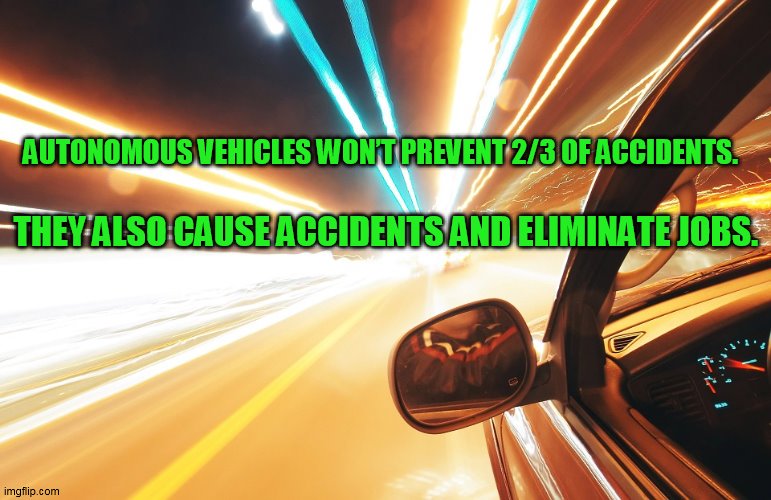 By B.N. Frank
By B.N. Frank
Over the years, there have been numerous safety issues reported about autonomous vehicles (AVs) (see 1, 2, 3), though Tesla models seem to be getting the most attention (see 1, 2, 3, 4, 5, 6, 7, 8, 9, 10, 11, 12, 13). Additionally, some experts are concerned that widespread AV deployment could actually increase pollution rather than decrease it. Health experts have voiced concerns about biologically and environmentally harmful electromagnetic radiation emitted by AV technology as well (see 1, 2, 3, 4). Nevertheless, AV manufacturers and proponents have not been discouraged. Apparently, U.S. federal safety officials haven’t been either.
From Smart Cities Dive:
Long-awaited safety rule a ‘big step’ for future of AVs
It will be easier for automakers to release cars with automated driving technology without seeking exemptions, one scholar explained, but won’t change the testing happening in some states and cities.
Federal safety officials took a step forward in getting fully autonomous vehicles on the road with the release of safety standards for cars that do not contain steering wheels or traditional drivers seats.
The rule released last week by the National Highway Traffic Safety Administration (NHTSA) anticipates a future where automakers come out with cars that have fully automated driving systems. The agency lays out rules meant to protect occupants in autonomous vehicles (AVs).
The move marks a first-of-its-kind recognition from the U.S. Department of Transportation that not all cars will have a steering column, drivers seat and pedals. Ariel Wolf, general counsel for the Autonomous Vehicle Industry Association, said in a statement the rule is “an exciting step toward safer roads, transformed mobility and new economic opportunities” with AV development.
“Many cities and states have already recognized the benefits, which is why they’ve established frameworks to enable AV testing and deployment,” said Wolf, whose group represents automakers and tech companies. Wolf said the rule “is a boost to the industry’s investments in local communities.”
Bryant Walker Smith, associate professor of law at the University of South Carolina and an affiliate scholar at the Center for Internet and Society at Stanford Law School, said the long-awaited rulemaking is a “big step” in the regulatory process for driverless cars. The regulatory changes, he said, will make it easier for automakers to release cars with automated driving technology without seeking exemptions from NHTSA. For example, the NHTSA rule details considerations like airbags, seat placement and windshield materials in a car that may not have a traditional driver’s seat or steering column.
However, Smith said, it is not a blanket approval for driverless cars and won’t change the testing that companies are doing in some states and cities that have opened the door to AV pilots.
“This is an indication that NHTSA is proceeding with its regulatory process. It does not change the very permissive regimes in some states like Arizona or the more regulatory-focused regimes in California and other states,” he said.
The rule, which has been in the works for years as automakers pressed forward on AV technology, is just one regulatory step industry stakeholders and policymakers have been anticipating. NHTSA is still set to release a framework for automated driving systems safety.
A 2020 policy document says the agency is also working on alternative metrics and safety assessment models for AVs along with rules regarding functional safety, human controls and accessibility considerations. Additionally, NHTSA has been gathering information about crashes involving autonomous vehicles, which some have seen as a move away from the government’s traditionally hands-off approach to AV pilots.
Congress has debated comprehensive AV legislation for years, but no bill has emerged.
“As the driver changes from a person to a machine in ADS-equipped vehicles, the need to keep the humans safe remains the same and must be integrated from the beginning,” said NHTSA Deputy Administrator Steven Cliff in a statement. “With this rule, we ensure that manufacturers put safety first.”
Safety advocates say it will be incumbent on federal agencies to not just permit automated driving systems, but to ensure that those systems meet the same safety requirements as vehicles currently on the road. Cathy Chase, president of Advocates for Highway and Auto Safety, said that while the organization is supportive of new technology that could make driving safer, it wants assurance that there are minimum performance standards.
“Without standards, we are all unwitting participants in a big science project happening on our roadways,” Chase said. “The more vehicles that are out there without regulation, the more we are putting vulnerable road users in danger.”
Correction: We have updated this story to remove language that we erroneously attributed to Bryant Walker Smith.
Activist Post reports regularly about autonomous vehicles (AVs) and unsafe technology. For more information, visit our archives and the following websites:
- Wireless Information Network
- Electromagnetic Radiation Safety
- Environmental Health Trust
- Physicians for Safe Technology
Become a Patron!
Or support us at SubscribeStar
Donate cryptocurrency HERE
Subscribe to Activist Post for truth, peace, and freedom news. Follow us on SoMee, Telegram, HIVE, Flote, Minds, MeWe, Twitter, Gab, What Really Happened and GETTR.
Provide, Protect and Profit from what’s coming! Get a free issue of Counter Markets today.

Be the first to comment on "NHTSA Rule “will make it easier for automakers to release cars with automated driving technology without seeking exemptions”"